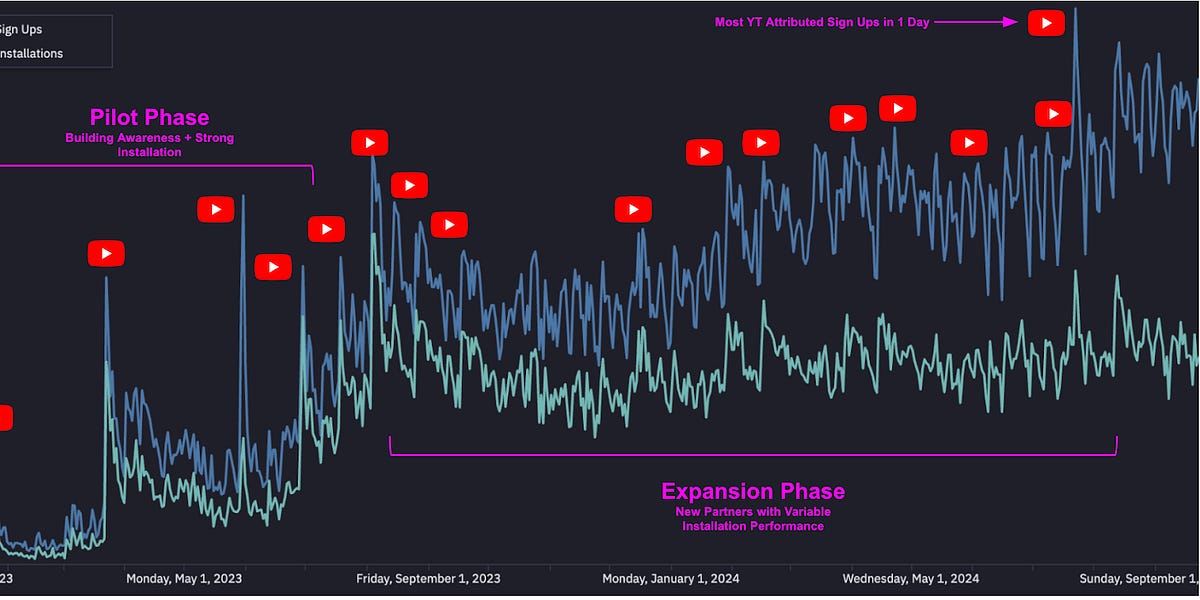- developer marketing newslepear
- Posts
- 🍐#86: Masterclass into YouTube influencers, last sign-up step idea, and more learnings on great docs
🍐#86: Masterclass into YouTube influencers, last sign-up step idea, and more learnings on great docs
Hey,
This is how my daughter eats a pear. What did it teach me about dev marketing? There is more than one way to do it 😉 #linkedinlunatics (those who know, know).

do
This week on the agenda:
Masterclass into YouTube influencers from Clerk
The last step of the sign-up process from Linear
More learnings on great docs from Dave Nunez
+ a few bonus links at the end
Total pearusing time: 5min
Before we start…
Clerk is looking for a Growth Marketing Manager.
The first insight this week comes from that very team and you could work with Alex and Nick who are just fantastic (you might have seen their comments/posts in the community slack) or just read what they did on the YT front.
You’ll run growth experiments across the whole dev journey, including new channels. Mostly focusing on growing activated signups
Oh, and this is a remote role but you need to be +-3 hours from MDT timezone.
Developer marketing insights
1. Masterclass into YouTube influencers from Clerk
Alex Rapp and Nick Parsons together with Gonto from Hypergrowth partners shared their experiences setting up and growing the YouTube creator/influencer motion at Clerk.
These are my takeaways:
You can just reach out to creators and ask if they’d be interested in trying your product. Simple as that. This is a nice tweak to transactional “will you promote us” outreach. “They are paying people to talk about them” is not the vibe you want to go for anyway. So creating that human relationship from the get-go helps.
Which format to choose? Doing long-form sponsored videos focused on their product alone didn’t really work. Switching to a format where their product was a part of a larger workflow/app was the way to go.
Give people creative freedom. They asked influencers to propose their content. They (should) know their audience best after all. Additionally, there was no push for publishing deadlines and a safe space to talk about the problems with the product.
People didn’t click on links in the video description. They looked for directional impact based on the correlation between videos being published and signup spikes
To find creators on auto-pilot they created YouTube scrapers that would look for specific keywords like “Clerk” or “React” in titles/descriptions etc. To vet them they looked at 10k+ creators with good engagement proxy metrics (view-to-subscriber ratio, likes, comments etc)
They invested slightly more (60-40) in smaller creators with bigger growth potential than established, big personal brands.
They treated it as a partnership: The Clerk team shared metrics, learnings from other creators, and feedback on the results they saw. They wanted it to work both ways. They want creators to succeed.
Engagement setup: In the testing phase they were open to what creators wanted. After a while, they gathered some data from various creators they worked with and used that to negotiate. Another approach you can use is just paying creators on CPM (cost per 1000 views). That ranged from $20-55 for across Hypergrowths portfolio companies.
2. The last step of the sign-up process from Linear
This is a nice little touch in the very last step of the signup process.
Linear asks you to do two things:
Subscribe to the newsletter with updates
Follow-up on their main social channel
The beauty of it is while this is an ask it is done so gracefully:
balances promotion with value for the user
It is explicit in what it asks for and explains each ask with a one-liner
makes the ask small enough that it makes sense to be an "impulse buy"
the CTAs are clear -> not only "follow us on Twitter" but also gives you their handle
Nice and simple and I am sure it gets some folks to subscribe/follow.
3. More learnings on great docs from Dave Nunez
Every time Dave Nunez, ex-Stripe Head of Docs shares his thoughts I learn something new.
My takeaways this time:
Push back when necessary vs the docs team, when things that are important to marketing (positioning, GTM strategy etc) need to be done right. They will respect you for it. But also use product/docs yourself to gain that trust.
Obsess over the getting started experience. Don’t do everything, but get that path to the first value great. Measure it by Time to X event too. To make it better, make people go through that experience and watch them do that and talk about what they think/feel (friction log it).
Instead of pushing people away to another link, try a hover display to give context.

Most documentation doesn’t need to exist. Especially when the product changes rapidly, maintaining all that content is hard. And then it doesn’t get done and it becomes out of date and unhelpful. Focus on the experiences of the core users and trim the rest.
Need more developer marketing insights?
1. Work with me 🍐
"Thanks so much for your time and all the thoughtful feedback coming from the workshop.
I feel like we are in a much better place to start our website rebuild. "
If you want my help I do Workshops (60-minute session on whatever you want), Teardowns (audit+suggestions for your homepage, messaging, ads etc), and longer-term Advising.
2. Bonus links to check out
3. Join our Slack community
"Been here 20 min and already folks are sharing great advice."
2000+ dev tool CMOs, heads of growth, product marketers, and other practitioners talking shop.





Reply